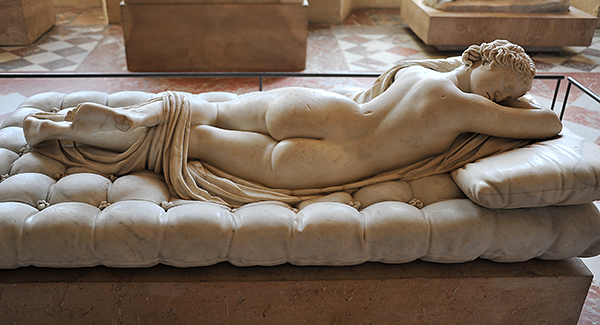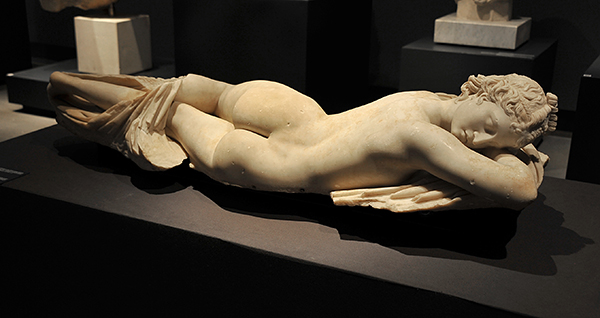
"Her prayers found favour with the gods: for, as they lay together, their bodies were united and from being two persons they became one. As when a gardener grafts a branch on to a tree, and sees the two unite as they grow, and come to maturity together, so when their limbs met in that clinging embrace the nymph and the boy were no longer two, but a single form, possessed of a dual nature, which could not be called male or female, but seemed to be at once both and neither."
Ovid, Metamorphoses (IV.288ff)
Ovid tells the story of the Naiad Salmacis and the beautiful youth Hermaphroditus, with whom she fell in love, to explain why the spring of this "rude uncivil nymph" (in John Dryden's phrase) had such an enervating effect on those who drank from it. Located near the mausoleum at Halicarnassus (the capital of Caria in Asia Minor), it had "the slanderous repute, for what reason I do not know, of making effeminate all who drink from it. It seems that the effeminacy of man is laid to the charge of the air or of the water; yet it is not these, but rather riches and wanton living, that are the cause of effeminacy" (Strabo, Geography, XIV.2.16). Vitruvius, in seeking to correct this vulgar error, relates how Greek colonists, having driven out the native inhabitants of Caria, established trade near the fountain, which was known for the purity of its water. Drawn back to the area, the tribes gradually lost their rude and savage ways. "Hence this water acquired its peculiar reputation, not because it really induced unchastity, but because those barbarians were softened by the charm of civilization." (On Architecture, II.8.12).
Hermaphroditus was the child of Hermes and Aphrodite, whose temple at Halicarnassus was close to the spring (On Architecture, II.8.11). In Ovid's account, they heed their son's request to curse its water and "infected the pool with this horrible magic power" so that any man who bathed there would be no more than half a man, grown weak and effeminate. In 1995, an elegiac poem in Greek dating to the second century BC (and so the earliest narrative about Hermaphroditus himself) was discovered at Salmacis that offers a very different perspective from Ovid's wanton nymph and chaste boy. Rather, she is the nursemaid who takes care of the young god and raises him to greatness"He who discovered marriage and was the first to bind the marriage bed in law. And she herself beneath the holy streams dripping in the cave tames the savage mind of men." Rather than emasculating men, the spring of Salmacis tames them for the domesticity of marriage. It is Hermaphroditus who represents an idealized union of male and female, yoking both in lawful marriage, and Salmacis, rather than overwhelming Hermaphroditus in her frenzied attempt to seduce him, who tempers the savage man.
This need for balance and proportion can be seen in Plutarch's cautionary treatise on marriage .
"Fishing with poison is a quick way to catch fish and an easy method of taking them, but it makes the fish inedible and bad. In the same way women who artfully employ love-potions and magic spells upon their husbands, and gain the mastery over them through pleasure, find themselves consorts of dull-witted, degenerate fools. The men bewitched by Circe were of no service to her, nor did she make the least use of them after they had been changed into swine and asses, while for Odysseus, who had sense and showed discretion in her company, she had an exceeding great love."
Coniugalia Praecepta (139A)
The association of Hermaphroditus with marriage can be seen as well in Theophrastus, who, in characterizing the superstitious man, has him purchase on the fourth and seventh days of every month myrtle and frankincense and a holy picture, and then spend the entire day sacrificing to Hermaphrodites and hanging garlands on them. The fourth day of the month was sacred to Hermes, whose masculinity can be seen in the ithyphallic herms that are garlanded, and the fourth day of the week named after him, just as it was in Latin. This is the earliest reference to Hermaphroditus, which here seems to have been a herm, and the dedications related to marriage or fertility. Writing a generation before Ovid, Diodorus Siculus comments that Hermaphroditus was a combination of both sexes, "in that he has a body which is beautiful and delicate like that of a woman, but has the masculine quality and vigour of a man," who, born rarely into the world, presaged the future either for good or evil (The Library of History, IV.6.5)in other words, a true hermaphrodite and not the metamorphosis of two sexes into one.
The Borghese Hermaphrodite is one of several Roman copies of a Greek bronze by Polycles (Pliny, XXXIV.80; a tentative attribution since the appearance of the original is not known). It was sold under some duress by Prince Camillo Borghese in 1807 to Napoleon Bonaparte, the brother of his wife Pauline. Indeed, much of the Borghese sculpture collection, including 154 statues and 160 busts, were acquired by the French and placed in the Louvreas were the Borghese Gladiator and Borghese Ares.
Remarkably, another copy of the sleeping hermaphrodite was found in 1781 and took its place in the Galleria Borghese. It was restored in the eighteenth century by Andrea Bergondi, who added the head and left leg, and placed the reclining figure on a sheeted bed in imitation of Bernini's earlier work. The sculpture below, in which the left leg is missing, is in the Palazzo Massimo alle Terme (Rome).

Lady Townsend was said by Horace Walpole to have remarked, upon viewing his bronze copy of the sleeping hermaphrodite, that "it is the only happy couple she ever saw."
References: The Metamorphoses of Ovid (1955) translated by Mary M. Innes (Penguin Classics); Theophrastus: The Characters (1929) translated by J. M. Edmonds (Loeb Classical Library); Diodorus Siculus: The Library of History (1935) translated by C. H. Oldfather (Loeb Classical Library); Strabo: Geography (1917-) translated by H. L. Jones (Loeb Classical Library); Vitruvius, The Ten Books on Architecture (1914) translated by Morris Hicky Morgan (Loeb Classical Library); Plutarch: Moralia (1928) translated by Frank Cole Babbitt; Taste and the Antique: The Lure of Classical Sculpture 1500-1900 (1981) by Francis Haskell and Nicholas Penny; "The Invention of Marriage: Hermaphroditus and Salmacis at Halicarnassus and in Ovid" (2009) by Allen J. Romano, Classical Quarterly, 59(2), 543-561; The Letters of Horace Walpole, Fourth Earl of Oxford, Vol. 1: 1732-1743 (1903) edited by Mrs. Paget Toynbee.
See also Venus de Milo.